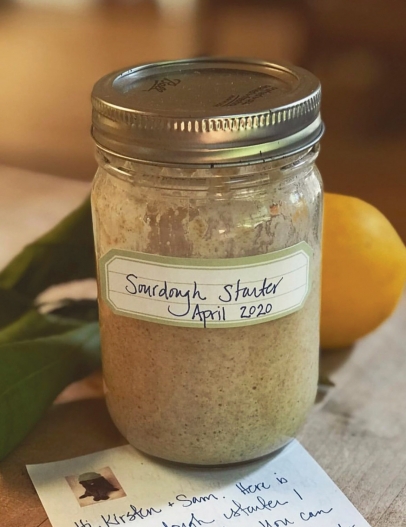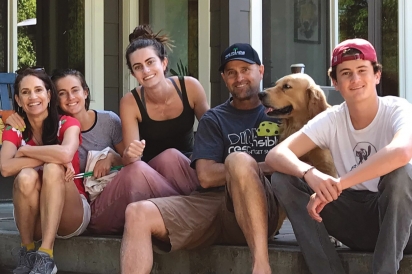Kneading Through the Pandemic
A Sourdough Diary
In the spring of 2020, when the governor first announced California’s shelter-in-place orders, the idea that a virus would take the lives of millions of people around the globe and shut down life as we knew it still sounded like a terrible—and paranoid—sci-firuse. It was just a few weeks later that I opened my front door to find a small Mason jar on the front stoop, with an attached note explaining, in the careful cursive handwriting of a neighbor friend, that it was a cup of her long-tended sourdough bread starter.
I have always said “I don’t bake.” Cooking works for my casual, intuitive and sometimes imprecise nature. Baking, with its precision and immovable chemistry, has felt restrictive to my improvisational kitchen self, the results too dependent upon an exacting regime. So, as I carried the gift jar from my stoop to the kitchen, I took a moment to appreciate the thoughtful gesture, then tucked the starter into the back of my refrigerator behind the mayo.
In the weeks and months that followed, pandemic life began to unfold. Or, rather, to fold in on itself. Our children returned from college, a few friends in tow, and for the first months our home became a shelter-in-place shelter for young adults. This was when things still felt like make-believe— strange, yes, but playful and optimistic, like camping out together. I didn’t have much time to think about the big picture because the tribe needed sustenance. Trips to the grocery store were surreal hazmat-suit-type outings. There were the N95 masks and gloves, and I recall debating between wearing a pair of Jackie O—style sunglasses or ski goggles to cover my eyes. I filled two grocery carts at a time, to minimize return trips, and wiped everything down with sterile wipes as I unloaded the bags at home. Flour was in short supply and eggs disappeared from the shelves. I secured fresh eggs from my stepfather, who keeps chickens in West Marin, and we enjoyed olive oil and fruit from our neighbors’ trees. Planning dinner became the highlight of my day when it was difficult to plan for anything.
Because I wasn’t going out to pick up a favorite Rustic Bakery batard or Della Fattoria Rosemary Meyer Lemon boule, fresh bread became a rarity. Yet, the sourdough starter remained neglected in the back of the refrigerator. That is, until a few weeks later when another friend dropped off three pounds of coveted organic bread flour (she had arrived at the market strategically early and scored). I understood then that the universe—and my friends—were asking me to bake bread. I found the little jar in the back of my fridge, read the attached instructions for enlivening the starter, and began my pandemic sourdough journey. The basic sourdough recipe on the miller’s website seemed manageable, and I found satisfaction in kneading the dough. The sourdough/shelter-in-place combo was already becoming a pandemic trope, and I immediately understood why; the tactility and repetition—punching and pounding, stretching and folding—helped me to steady scurrying thoughts.
By late spring, the unshakeable joy of an empty-nest mother whose brood has come back home remained, but by now the reports of hospitalizations and deaths were growing, we knew of people who were ill, and the reality of Covid-19 had set in. Our family felt both fortunate to be OK, and increasingly unsettled. Our middle daughter’s college graduation was canceled, and she and her friends didn’t know if they should be looking for jobs or applying for unemployment. My son, who at 19 had been mid-life-launch when the pandemic brought him home, found online courses miserable, went through a remote breakup and felt stuck. And then, as summer arrived—cue the haunting soundtrack—the sky literally turned dark, tinted brownish orange. In what seemed like an impossible dystopian plot twist, much of Northern California burned. It became more difficult to breathe. We set up air purifiers and taped door frames to prevent smoke from getting in through the imperfect seals of our 75-year-old home. The PurpleAir website, which we checked compulsively, confirmed that it was not safe to be outside, with air quality index numbers soaring into the 400s.
Our salve over the previous months—walking in open spaces—was no longer available. We experienced a kind of anxious restlessness, a sense of being trapped, that had not been part of our lucky lives to date. We, along with the rest of the surviving globe, lived with sorrow about lives lost to the virus and to fires. We experienced a concurrent sense of survivors’ guilt and suspended doom: Yes, we are OK, but it feels like we are not OK.
Sourdough bread making became part of daily life. In the morning I kneaded away, sometimes for too long, working through the unknowns. Would we lose the elders in our extended family? Did my husband’s propensity for bronchial infections put him at high risk? Did my own autoimmune diagnosis put me in danger? Would my son, living away from us in an unsettled state (double entendre intended), find his way? Would friends in Sonoma lose their home to fire? What air quality numbers made it safe to walk outside?
We bought a fire-safe box for irreplaceable items and took photos of our possessions, embracing the reality that our house, which sits on the edge of thousands of acres of open space, might burn at some point. My 20-something children returned to their own lives in various parts of California, and I worried for their safety. And then my beloved stepfather grew gravely ill with a mysterious non-Covid illness (he was eventually diagnosed with an almost-unheard-of deer- and tick-borne disease). He was in and out of the hospital over the course of months, near death. I could help my mother with his care when he was at home in West Marin, but was not allowed in the hospital. As was true with everything about life during the worst months of the pandemic, there were more questions than answers, and no clear path forward.
Baking became my clear path forward. The detailed instructions, the executable chemistry—exactly what had dissuaded me in the past—drew me to this new hobby. I loved tending my sweet little starter, a living cluster of organisms that was predictably responsive to my care, bubbling in happiness after a flour feeding. I even loved striving for precision, and then feeling and tasting the results. I savored those (very) rare moments of surprised delight in my own creation, those days when I wrapped half of a still-warm loaf in brown paper to deliver to my elderly neighbor’s back doorstep—he had been especially isolated during the pandemic as he cares for his wife who suffers from Alzheimer’s. Bread, in its yeasty warmth and comfort, offered a kind of intimacy in an era of disconnection.
Over the past year, I failed many times as I attempted to make a delicious sourdough loaf of bread. My loaves have been dense. My loaves have been chewy. My loaves have been light and fluffy, but with an unimpressively soft crust. Some of my loaves have been flavorless, not richly layered, tangy and balanced, because I was impatient with my starter. But I have not stopped trying, once or twice a week, to make fresh bread. I follow the recipes carefully—from King Arthur’s Basic Sourdough Bread to La Brea bread goddess Nancy Silverton’s complex Rustic Sourdough recipe. As months passed, I experimented with timing—proofing in a barely warm oven, or proofing over days in the fridge—and settled on a clay tagine pot as my favorite lidded baking vessel. I have added chia, flax, poppy, sesame, sunflower or pumpkin seeds, both to the interior and the crust. I have used white, whole-wheat, spelt and rye flour, in various combinations. And although I have mostly stuck to kneading (the “need to knead”), I have also experimented with the classic No-Knead recipe. Want to look forward to the next day? Plan a morning boost of freshly baked bread.
Our younger two, who had returned to Southern California, both caught the virus. Despite her age (23), my daughter was quite ill for 10 days. She made it through, thanks to loving attention from her roommates. In the face of lousy job prospects, she and her best friend decided to launch their own clothing company and she is thriving. My son was fortunate to have no symptoms from the virus, and in a strange way—a story too long for this piece—the pandemic allowed him to change his life. He dropped out of college to pursue music and is happier than I have seen him, maybe, ever. My stepfather has recovered from his terrible illness and is back to spoiling his beloved chickens. He still pinches himself periodically, just to make sure he is actually alive. Travails wrapped in what feel like miraculous blessings.
Life has changed. Thanks to scientists, we are doing better here in the United States, but that does not diminish the deep tragedy of the past year and a half, or the ongoing struggles in other nations. An unfathomable number of souls have passed away. Mothers and fathers, nurses, doctors and orderlies, teachers and administrators—all taken by Covid. Our dear friend in India lost two of his best friends, both young fathers. And here in California, where many are vaccinated and public life has resumed, we hold our breath in perpetual preparation for fire, praying for rain, any rain. Collectively, we are more tender and frail.
Over the past year and a half I have tried to honor the dead in my small way, reading as many obituaries as possible, sometimes crying as I read, or later as I knead, my salted tears becoming part of the process of binding and fermentation in the dough, the mysterious and chaotic, but also the elegant and reliable dance of molecules that has helped me to find a sense of security in the darkest days of the pandemic, a humble, ritualistic kind of faith. We nourish and are nourished. The dough rises, as it has for eons, and we bake, filling our homes with a fragrant kind of hope.






